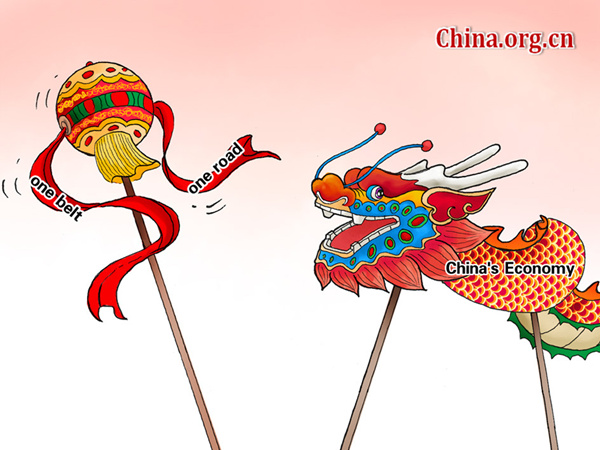The 'Belt and Road' strategy a prime opportunity for Chinese dream
- By Han Fangming
 0 Comment(s)
0 Comment(s) Print
Print E-mail China.org.cn, March 11, 2015
E-mail China.org.cn, March 11, 2015
|
[By Zhai Haijun/China.org.cn] |
China regards its peripheral region as the basis for its establishment and prosperity. In proposing the "Belt and Road" concept, China wanted to draw on the historical heritage shared by the countries involved to shape a community of interest, responsibility and security before such a mechanism will influence the common fate of these countries. In the process, China's international influence and soft power will naturally be on the rise.
Third, the strategy will emphasize China's comparative advantage in globalization and comprehensively raise China's competitiveness. In shaping the "Belt and Road," China will make the most of its advantage in the global division of labor. In other words, China's role in the global chain of industry will be upgraded from the labor-and-resource intensive end to the technology-and-capital intensive end.
The ancient land and maritime silk roads were the official channels through which China maintained a connection with the rest of the world. They were the meeting points for the Chinese, Indian and Greek civilizations. Today, the revitalization of both silk roads will benefit 4.4 billion people in some 65 countries in Asia, Europe and Africa. The connected regions will have an economic capacity of US$21 trillion, accounting for 29 percent of the world's entire volume.
In 2013, China's trade volume with countries along the two routes exceeded US$1 trillion, comprising of one quarter of its total trade volume. In the past 10 years, growth in trade with these countries has stood at 19 percent, 4 percent higher than China's average annual trade growth.
There is greater room for growth in the Thirteenth Five-Year Plan (2016-20), which is still being drafted, as it predicts that China will import US$10 trillion worth of goods, make more than US$500 billion worth of foreign investment and send some 500 million tourists overseas. China's neighboring countries and countries along the "Belt and Road" routes will be the first to benefit.
The "Belt and Road" strategy stresses shared development. It calls for openness and inclusiveness in that the Chinese strategic concept seeks cohesion with similar strategic frameworks already in existence, rather than to reinvent the wheel. It also seeks inclusiveness so that it will not stand in conflict with the interests of Russia, the United States, Europe or Japan, but underscores the common ground it will bring.
In other words, China is expanding its own opportunities globally, while consolidating its strategic partnership with other countries through the "Belt and Road" initiatives.
Han Fangming is a member of the Chinese People's Political Consultative Conference and chairman of the Charhar Institute.
Opinion articles reflect the views of their authors, not necessarily those of China.org.cn.







Go to Forum >>0 Comment(s)